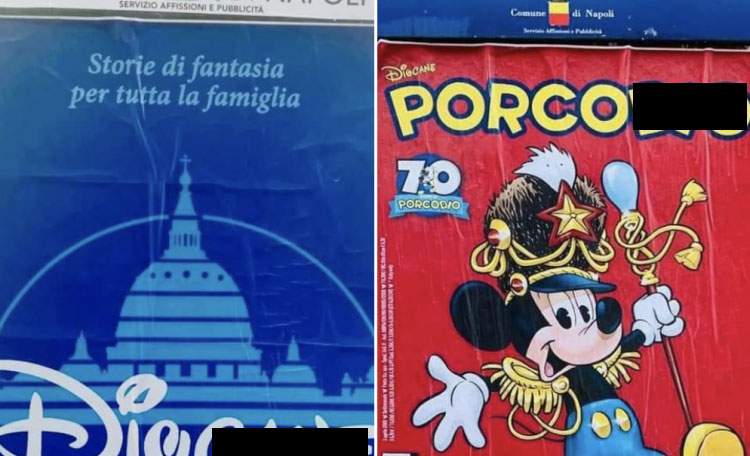Naples has for the past few hours become the blasphemy capital of the world: in fact, Ceci n’est pas un blasphème, an arts festival for freedom of expression underway at PAN, is underway. The festival, curated by Emanuela Marmo, starts with some questions: “Is denouncing the financial powers of churches or their support of dictatorships and paramilitary organizations blasphemous? Challenging the custom of child brides or is the veil obligation unjust? Is exposing gender or role stereotypes constructed by traditions illegitimate? Dictatorships, child abuse, sexual discrimination-isn’t all this much more dangerous than blasphemy?” With exhibitions, lectures and events, Ceci n’est pas un blasphème thus aims to address these issues.
In the last few hours, however, the event has been at the center of controversy (on social media but also in local newspapers, with opposing interventions by intellectuals such as Peppe Barra and Maurizio Di Giovanni) because large posters stuffed with profanity have appeared everywhere in the city: the posters revisit famous commercials, election posters, and comic book covers (including Mickey Mouse) by putting profanity in the place of headlines and slogans. The authors of this subvertising operation are some artists invited to the festival (Ceffon, DoubleWhy, and Illustre >Feccia), which moreover is promoted by the City of Naples. However, the City did not know that these posters would be put up. “I immediately activated the marketing service to initiate controls. These posters, too, after the appropriate checks, as always happens with all abusive posters, will be removed by Napoli Servizi,” said Culture Councillor Annamaria Palmieri. “I would like to clarify,” she added, “that the festival has very selective characteristics: it can be viewed only if you have religious awareness, you can access it only if you are of age.”
The posters, being a subvertising intervention, are therefore a creative sabotage of the advertising spaces that took place without the knowledge of everyone, the municipality and the festival organization itself. The organization therefore disassociated itself but defended the motives of the artists who hung these posters around the city. “This is,” Emanuela Marmo explained, “their spontaneous and autonomous initiative, about which I know little, except what friends, acquaintances, and users report to me by sending me photos from Naples. It goes without saying that the councillorship or the city administration knows even less. I find it ridiculous and specious to put them on the spot about a circumstance that totally excludes their involvement. Subvertisers do not inform anyone of their actions, much less ask permission: otherwise, their art would not be called subvertising. I take this opportunity to thank the artists and to remind those who read me what this art form is. Subvertising ’abuses,’ sabotages and creatively reappropriates the spaces of advertising and propaganda to return messages of protest, of freedom, subverting the concepts that habitually educate and condition us. Instead of contaminating our perception in favor of passive consumption of ideas and imagery, it provokes our attention to content that we would not otherwise be offered. It is culture, it is critical thinking offered to all. These signs populate our streets without seeking profit, without privatizing knowledge. The contrariety of citizens, who have pointed out that posters also appear near places of worship or frequented by children, prompts me to believe even more strongly that subvertising actions are essential. These same citizens, in fact, have nothing to say, are absolutely addicted to the advertising messages that also crowd those same streets, in proximity to the same places of worship or frequented by children. Advertising messages that inoculate an eroticized use of the female body and childhood, that promote aesthetic standards that are frustrating and unattainable for ordinary people, that associate beauty with the possession of useless, expensive, classist goods. Lo and behold, to all these diseductive messages, devoid of ethics, citizens do not oppose, they allow themselves to be seduced by them. So welcome subvertising, which, in Ceffon(i) strokes, awakens us from our torpor.”
Meanwhile, there are those who have already responded creatively to the profanity: some madonnari, the artists who create religious images on the street, showed up in front of PAN, the festival venue, on Tuesday to fill the street with images of Jesus, the Virgin Mary and the saints. A response that was, moreover, appreciated by the festival organization, as it shifted the confrontation to the level of ideas, creativity, iconography and the relationship with the public and collective space and not to that of controversy. “A beautiful, intelligent, civil response that gives relief,” Marmo commented.
 |
| Naples, posters with profanity appear to promote exhibition. Controversy ensues |
Warning: the translation into English of the original Italian article was created using automatic tools. We undertake to review all articles, but we do not guarantee the total absence of inaccuracies in the translation due to the program. You can find the original by clicking on the ITA button. If you find any mistake,please contact us.